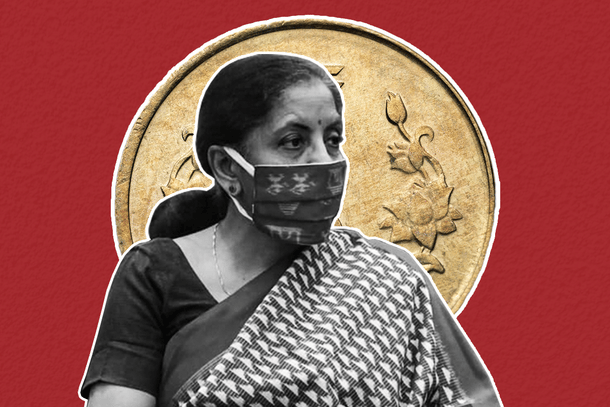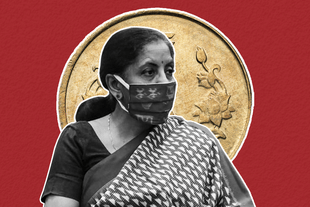Economy
Memo To Finance Minister: Expanding Tax Revenues Or Tax Base Needs New Metrics, New Approach
R Jagannathan
Aug 18, 2020, 04:25 PM | Updated 04:25 PM IST
Save & read from anywhere!
Bookmark stories for easy access on any device or the Swarajya app.


You can also read this in Hindi- वित्त मंत्री को संदेश- कर राजस्व या कर आधार बढ़ाने के लिए नए मापदंड, पद्धति ज़रूरी
Prime Minister Narendra Modi last week unveiled what he called a “seamless, painless and faceless” tax system along with a taxpayers’ charter of rights and responsibilities. Since this should reduce the powers of “faceless” bureaucrats to harass and extort money from taxpayers, it is certainly a move in the right direction. The Prime Minister also regretted that in a country of 1.3 billion people barely 15 million paid taxes.
However, if the Modi government is expecting any dramatic turnaround in terms of direct tax receipts by merely making the taxman look friendlier behind a computer screen, he may be expecting too much.
This is because tax revenues depend on having the right revenue philosophy, not just greater transparency. If the objective is more revenue, that can be ensured even with a much smaller taxpayer base. If the objective is a much larger tax base, that needs a different approach.
The truth is far more people actually pay taxes than the 15 million that the Prime Minister mentioned. According to time series data released by the revenue department, in fiscal 2017-18 (assessment year 2018-19), nearly 85.5 million people paid income taxes even though only 63.3 million filed original or revised tax returns.
This implies that over 22 million taxpayers don’t file returns since their taxes are collected by way of deductions at source. And if only 15 million of the tax return filers are actually paying a decent net amount of direct taxes, it calls for a wholesale re-examination of our tax assumptions rather than just presuming it is about widespread non-compliance.
We are probably using the wrong metrics to judge how much the taxman ought to collect rather than what is the right amount to collect and from whom.
India’s tax-GDP (gross domestic product) ratio is around 11-12 per cent, of which roughly half comes from direct taxes. But if we factor in the reality that millions or ordinary citizens pay speed money and bribes to get basic things done, our actual tax-GDP ratio may be much higher. Private collection of taxes cannot be left out of the tax-GDP matrix, even if these figures can only be guesstimated.
There is a strong case, in fact, to discard the tax-GDP ratio itself as a useful metric in the Indian (and probably global) context, when these ratios vary so widely across the world.
The US, according to World Bank data, has a lower tax-GDP ratio (9.6 per cent) than India (11.2 per cent). The Nordic countries have higher ratios in the range of 20-30 per cent, while Switzerland is below India at 10.1 per cent.
In India’s case, if we add private tax collections (ie, bribes, speed money, etc), and we start looking at the tax-GDP ratio as some kind of important metric, we are more likely to go wrong in our tax policies.
Several reasons why.
One, the tax-GDP ratio is not a variable independent of the level of economic activity in the country. This implies that if economic activity grows faster than taxes, it is not necessarily a bad thing, for it is economic activity that creates demand and jobs.
What governments should be concerned about is whether revenues are adequate to meet important state expenses on public goods, and not the ratio itself. If most things that governments ought to do are getting done with a lower ratio, this is success, not failure. The ratio is useful only for long-term studies of the linkage between revenues and growth, not as an end in itself.
Two, an obsession with the tax-GDP ratio forces governments to think they may be under-taxing citizens, when this may not be the case at all. If you think that more citizens ought to be paying taxes or that the few who are already paying taxes should pay more, you create incentives for evasion and corruption.
An obsessive pursuit of the tax-GDP ratio may itself become a promoter of corruption as it forces taxmen to resort to underhand means to raise revenues – which is what the new faceless, painless regime is supposed to end.
Three, in a low-trust society riven by caste, religious and linguistic divisions, governments must actually aim to leave more money in the hands of the people, since fears about whom your taxes may benefit may make people evade taxes and contribute more directly to their own communities through charities and trusts.
It is possible to have high tax rates in homogenous and monocultural countries where the taxpayer knows that his own kith and kin will benefit from the social security financed by taxes paid by the individual today. It is not possible to do so when inter-community cohesion is such a big question-mark in India – or the US, for that matter.
Four, in a country which has high product taxes, especially something like our goods and services tax (GST), there has to be some correlation between income tax rates and GST. Most businesses in India are in the informal sector, where businesses are individually-owned firms or proprietorships.
This means a high GST turnover should imply high levels of personal incomes too, and when there is a mismatch, the taxman will suspect evasion. This is one reason why most small firms still report lower sales revenues in their books so that their personal income tax dues do not go through the roof.
Two khatas, one for cash and another for GST, is much the norm now. This implies that income tax rates need to be lower to prevent a misalignment between GST turnover and personal tax liabilities. The current GST structure, with multiple rates and exclusions from the GST net (the composition scheme, etc) is needed only because most small GST payers do not want to be caught in the direct taxes net.
Five, in a country where per capita income is half the tax-exempt rate of Rs 2.5-3 lakh depending on age (the latest per capita income is Rs 134,226 in 2019-20), clearly our tax exemption rate is too high, not low.
This also explains why we have so few taxpayers relative to population. At the per capita level, everyone from domestic workers to personal drivers to plumbers and electricians would be taxpayers if the basic exemption were linked to per capita incomes.
Six, if the top corporate tax rate is lower than the top individual tax bracket, it is an invitation to make individual income look like corporate income by erecting a middleman company to record incomes due to the individual, with the individual who owns the company showing very little personal incomes. This is the kind of thing we don’t want to encourage. Many film stars earning in crores apparently do this kind of thing.
More important, how is it even feasible to expand the tax base when half the population (agriculture) is tax-exempt, and large portions of the urban non-poor not only don’t pay taxes, but actually benefit from subsidies (gas, foodgrain, etc).
Three conclusions follow.
Let’s forget the tax-GDP ratio as a useful metric. Let’s also steadily lower income tax rates to 15 per cent, or roughly where the average GST rates should head over the medium term. And, yes, the 22 million taxpayers who don’t file returns offer us a clue on what we should do: focus more on tax deduction at source in more and more activities, and less on tax returns. The latter only leads to lots more paperwork. We need more taxpayers paying a lot less than fewer taxpayers paying too much.
Jagannathan is former Editorial Director, Swarajya. He tweets at @TheJaggi.




